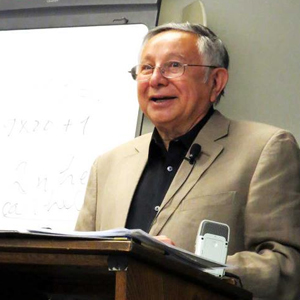Ramón Arzápalo Marín
Researcher
Universidad Nacional Autónoma de México

Dr. Ramón Arzápalo Marín received a Greenleaf Visiting Library Award in Spring 2013 to support research on The Colonial Maya Texts - Recent Contributions to the Theory of Semiotic Translation. At the time of the award, he was a full-time researcher affiliated with the Universidad Nacional Autónoma de México.
Dr. Arzápalo holds a PhD in philosophy from the University of Cologne in the Federal Republic of Germany (1972) and has carried out post-graduate studies at the Universities of Pennsylvania and Indiana in the United States, the University of Alberta in Canada, and at the Universidad de la República in Uruguay. He has given 155 seminars and courses in Mexico and abroad, and some 70 presentations on topics within his fields of study. Arzápalo has organized 24 national and international academic meetings and has given more than 70 papers at academic congresses held in North America, Europe, Asia and Mexico. He is a member of the European Academy of Science, Art and the Humanities (since 1989), of the Mexican Academy of Sciences (since 1994), and forms part of the National Roster of Researchers in Mexico (since 1985), the Mexican Association of Anthropologists (since 1987), and has served as its president from 1993-1995. Arzápalo is also a member of the Latin American Association of Linguistics and Philology, where he is the coordinator of the Committee on Amerindian Linguistics.
Title of Research : The Colonial Maya Texts - Recent Contributions to the Theory of Semiotic Translation
While at UNM, Arzápalo drew upon library archives to examine how Maya civilization is characterized by the development of a complex writing system that allowed members of this high culture to record their scientific, artistic and especially their historical texts. For a thorough understanding of their messages it is necessary to become acquainted with the script that they used for books, murals, and stellae. In his presentation on research findings, Arzápalo provided an overview of the structure and development of the hieroglyphs or written signs relied on by the Maya for these records until the arrival of the Spaniards. He also offered a critical analysis of the nature of this script based on recent, extensive research on documents of the Colonial period. The analysis of an encoded text taken from The Book of Chilam Balam of Chumayel is key to laying the foundation for a solid methodology for interpreting pre-Columbian texts written by the Maya. However, in order to correctly interpret the messages indicated by the analytical components, it is important to also consider such pragmatic information as their place in history and the surrounding social interrelations. He argued that the analytical heuristic should clarify some intercultural phenomena, usually overlooked since the 16th century, that have damaged interethnic relations.
